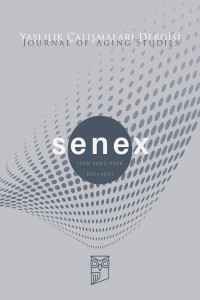PUBLICATION GUIDELINES
Senex: Journal of Aging Studies invites submissions in the following areas;
*The word limits listed below include abstract, text, and references. Tables and figures must not exceed an additional 5 pages.
- Research Articles
Research articles present the results of original qualitative or quantitative research. These manuscripts may be no longer than 6,000 words. The word count includes; abstract, text and references. Tables and figures must not exceed an additional 5 pages. The text is usually divided into sections with the headings: Background, Aims, Method, Implications, and Results. Subheads may also be needed to clarify content.
- Notes From The Field
Notes From the Field is important and innovative texts that are not as long as research articles, but are equivalent in quality. These manuscripts may be no longer than 3,000 words. The word count includes; abstract, text and references.
- Theoretical Interventions
Writings under the heading of the theoretical interventions should consist of debates that present an argument in around current issues in the field of aging studies. These manuscripts may be no longer than 6,000 words. The word count includes; abstract, text and references.
FORMATTING
Manuscripts are to be submitted in Microsoft Word or a Word compatible program. Manuscripts submitted in other formats will be returned to the corresponding author for correction prior to editor review. Please DO NOT submit PDF versions of your manuscript submission materials.
Senex: Journal of Aging Studies has a double-blind review policy. Therefore, we require authors to submit TWO versions of the article file, anonymous and non-anonymous. Please send ONLY these two files, the anonymous and non-anonymous manuscript files. Manuscripts must be prepared in accordance with APA 6th Ed. rules.
Instructions for Anonymous Files
Please send an anonymous version of your manuscript with no author names or contact information on the title page, blinded acknowledgment details, and removed other self-identifying author information. Be sure to check there are no self-references in the text itself that would reveal the identity of the authors. Please remove those instances and insert the term “blinded for review” in its place. This includes self-references to your name and University/Institute. Peer-reviewers may see this version.
Instructions for Non-Anonymous Files
Please send a complete version of the manuscript with all of the author and acknowledgment details. The editors will see this version.
Abbreviations
Ensure that the use of abbreviations is clear and that each one is defined in the text at its first mention only.
In-text References and Citations
Refer to the APA 6th ed. for style. References in text are shown by citing in parentheses the author’s surname and the year of publication. If a reference has two authors, the citation includes the surnames of both authors each time the citation appears in the text. When a reference has more than two authors and fewer than six authors, cite all authors the first time the reference occurs. In subsequent citations, and for all citations having six or more authors, include only the surname of the first author followed by ‘‘et al.’’ Multiple references cited at the same point in the text are in alphabetical order by author’s surname.
COMPONENTS OF THE MANUSCRIPT
Title Page
A title page should be a completely separate page that includes the following:
- Title of the manuscript (APA recommends that a title be no more than 12 words).
- All authors’ full name(s), affiliations, and email addresses.
- The corresponding author should be clearly designated.
Abstract and Keywords
On a separate page, each manuscript must include a brief abstract. Structured abstracts for Research Articles should be between 150-250 words, and must include the following headings: Background, Aims, Method, Implications and Results. There may not be structured titles for Notes From The Field, and Theoretical Intervention manuscripts but the word limit applies to abstract of these manuscripts. Below the abstract, authors should supply three to six keywords that are NOT in the title.
Text
The text of Research Articles should follow the headings included in the structured abstract. Notes From The Field, And Theoretical Interventions should also be divided into headings, as appropriate for the submission. Articles may need subheadings within some sections to clarify their content. The Implications should not merely restate the results but should interpret the results and specify the policy and/or practice implications.
Reference List
Arrange alphabetically by author’s surname cited in the main text; do not number. The reference list includes only references cited in the text. Please see APA 6th. Ed. for details.
Tables
Tables are to be numbered consecutively in the text and a short title must be found for each one on the table. Place table footnotes immediately below the table, using superscript letters (a, b, c) as reference marks. Asterisks are used only for probability levels of tests of significance (*p<0,05).
Figures/Illustrations
Please include your figures at the text into sections to which they relate. Senex: Journal of Aging Studies reserves the right to reduce the size of illustrative material. Figures must be professionally lettered in a sans-serif type (e.g., Arial or Helvetica). Figures should have a short title under the shape.
ADDITIONAL POLICIES AND CONSIDERATIONS
Permissions for Illustrations and Figures
Permission to reproduce copyright material, for online publication in perpetuity, must be cleared and if necessary paid for by the author. Evidence in writing that such permissions have been secured from the rights-holder must be made available to the editors. It is also the author’s responsibility to include acknowledgments as stipulated by the particular institutions.
Ethics
Senex: Journal of Aging Studies expects that authors will observe high standards with respect to publication ethics. For example, the following practices are unacceptable:
- Falsification or fabrication of data,
- Plagiarism, including duplicate publication of the authors’ own work, in whole or in part without proper citation,
Allegations of unethical conduct will be discussed initially with the corresponding author. In the event of continued dispute, the matter will be referred to the relevant institutions for investigation and adjudication.
Statement of Informed Consent
All participant in researches have a right to privacy that should not be infringed without informed consent. Identifying information, including participants’ names, initials, or identification numbers, should not be published in written descriptions, photographs, and pedigrees unless the information is essential for scientific purposes. Participants (or parent or guardian) gives written informed consent for publication. Authors should identify individuals who provide writing assistance and disclose the funding source for this assistance. Identifying details should be omitted if they are not essential. Complete anonymity is difficult to achieve, however, and informed consent should be obtained if there is any doubt. For example, masking the eye region in photographs of participants is inadequate protection of anonymity. If identifying characteristics are altered to protect anonymity, such as in genetic pedigrees authors should provide assurance that alterations do not distort scientific meaning. Ethical responsibility for participation in research belongs to the author.
Conditions for submission
Submission of a manuscript implies that it has not been published or is not under consideration elsewhere. If accepted for Senex: Journal of Aging Studies, it is not to be published elsewhere without permission. As a further condition of publication, the corresponding author will be responsible, where appropriate, for certifying that permission has been received to use copyrighted instruments or software employed in the research and that human or animal subjects approval has been obtained.
Review Process
All papers published in Senex: Journal of Aging Studies are subject to peer review. Peer-reviewed by Editors, manuscripts are sent to at least two independent referees for evaluation. Reviewers advise on the originality and scientific merit of the paper; the editors make all final decisions on publication. The corresponding author will be notified via email with a decision and revision requirements, if applicable. Please ensure that email addresses are current for notification purposes. Papers that are outside the scope of the journal, that do not comply with the guidelines below or are otherwise judged to be unsuitable by the editor will be rejected without peer review.
PAPER ACCEPTANCE INFORMATION
Licenses and Copyright
It is a condition of publication in Senex: Journal of Aging Studies that
authors grant an exclusive license to journal. This ensures that
requests from third parties to reproduce articles are handled
efficiently and consistently and will also allow the article to be as
widely disseminated as possible. As part of the license agreement,
authors may use their own material in other publications provided that Senex: Journal of Aging Studies is acknowledged as the original place of publication.
By submitting a manuscript for consideration for publication, you
confirm that you are the corresponding/submitting author and that Senex: Journal of Aging Studies may retain your email address for the purpose of communicating with you about the submission.
OPEN ACCESS POLICY
The Senex: Journal of Aging Studies adopts the open Access policy, and the journal published electronically (online) throughout the year.
Manuscripts are published in website after completing the independent blind review process. With the articles published throughout the year, the number of the journal relevant year will be completed by the end of December.
All articles published in Senex: Journal of Aging Studies are open to public use; and used freely, in free form, without permission from the publisher and author (s), and can be downloaded, distributed and used provided that the source is shown.

























